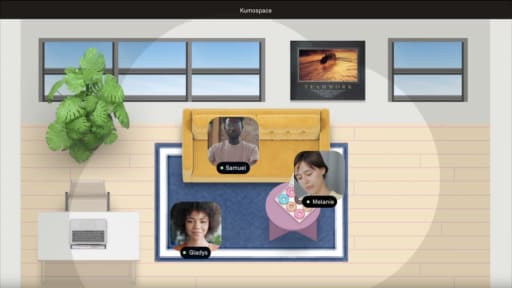Searching for the best conferencing call services for 2025? With so many platforms available, choosing the right one can have a major impact on how your team collaborates and communicates. In this guide, we break down the top platforms, reviewing their key features, pricing, and overall usability so you can make an informed decision.
Whether you’re managing a small team, coordinating cross-department meetings, or supporting a large enterprise, this overview will help you identify the conferencing call solution that fits your workflow. From essential tools for everyday check-ins to advanced systems designed for high-volume communication, you’ll find reliable options that support clear, efficient, and productive remote meetings.
Key Takeaways
- The top conferencing call services in 2025 include Kumospace, RingCentral, Zoom, Microsoft Teams, and Cisco Webex, each offering unique features tailored to different business needs.
- Key considerations when choosing a conferencing service include scalability, security, integration with existing tools, and customer support options to support effective communication.
- Free conferencing call services, like FreeConferenceCall.com, are useful for small teams or budget-conscious users, but they typically come with limitations in features and participant capacity.
Top Conferencing Call Services of 2025

The landscape of conferencing call services in 2025 is diverse and dynamic, catering to a wide range of business needs. Whether you’re looking for an all-in-one solution, a versatile communication platform, or a free service, there’s something for everyone. The top conference call services this year include:
- Kumospace
- RingCentral
- Zoom
- Microsoft Teams
- Cisco Webex
- GoToMeeting
- FreeConferenceCall.com
- Dialpad
- Vast Conference
- ClickMeeting
These services offer unique features that support remote communication and collaboration. From audio and video meetings to team chat and collaboration tools, they provide clarity and easy setup for any meeting scenario. The variety in offerings means you can find a service tailored to your specific requirements, whether you’re a small team or a large organization.
Here are some communication platforms and their key features:
- Kumospace: Provides an integrated platform combining VoIP and conferencing services.
- RingCentral: Offers a flexible standalone or unified communications platform.
- Zoom: Known for its video conferencing capabilities and high participant limits.
- Microsoft Teams: Integrates with Microsoft 365 to support productivity and collaboration.
Kumospace – The Virtual Office That Brings Teams Together
Kumospace stands out as an all-in-one virtual office platform that helps remote and hybrid teams collaborate more naturally. Instead of juggling endless video calls and chat threads, Kumospace brings everyone into one shared digital workspace where people can talk, brainstorm, and build culture in real time.
Key features include:
- Spatial audio and HD video that make conversations feel organic
- Virtual rooms for meetings, co-working, and social hangouts
- Screen sharing and whiteboards for team collaboration
- Status indicators and movement controls that mimic real offices
- Integrations with everyday tools for smoother workflows
What makes Kumospace notable is its ability to create presence and connection, something many remote teams struggle with. Whether you’re a small startup or a growing global team, Kumospace scales with you, helping everyone feel more engaged and productive.
From quick check-ins to company-wide events, Kumospace turns remote work into a shared experience, not just another video call.
RingCentral – Versatile Communication Platform
RingCentral offers a versatile communication platform that can be used as a standalone service or part of a unified communications platform. Notable features include strong whiteboard functionality, live notes, and AI transcription, making it a practical choice for conference calls.
Starting at $20 per user, RingCentral’s Core plan includes a complete phone system with tight integrations and enterprise-grade administration. This flexibility and range of features make RingCentral a solid option for businesses seeking to improve communication.
Zoom – Leader in Video Conferencing
Zoom is widely recognized for its video conferencing capabilities, high participant limits, and reliable features. Supporting up to 1,000 interactive participants in meetings, Zoom is suitable for large gatherings where full participation is required.
Features such as screen sharing, HD video meetings, and team chat support the overall meeting experience, making Zoom a leading option for many organizations.
Microsoft Teams – Seamless Integration with Microsoft 365
Microsoft Teams is designed for businesses already using Microsoft tools, offering seamless integration with Microsoft 365. This integration supports productivity and collaboration by allowing users to start or schedule meetings without switching applications.
Teams also offers extensive collaboration features, including real-time transcription and integrated productivity tools, making it a strong option for businesses focused on streamlined workflows.
Cisco Webex – Secure and Reliable
Cisco Webex is known for its strong security features, making it a preferred choice for large organizations, government agencies, and teams with strict compliance needs. Features such as password protection, access codes, and end-to-end encryption support secure and reliable conference calls.
The platform also offers scalable solutions with enterprise-grade features, making Cisco Webex a dependable option in the conferencing call services market.
GoToMeeting – Reliable Performance for Remote Teams
GoToMeeting provides reliable performance and accessibility across devices, including Mac, PC, iOS, and Android. Users can try GoToMeeting free for 14 days to experience its features before committing.
With capacity for up to 3,000 participants in its enterprise plan, GoToMeeting is suitable for large organizations and webinars. Its international dial-in numbers and solid features make it a reliable choice for distributed teams.
FreeConferenceCall.com – Best Free Option
FreeConferenceCall.com stands out as the best free option for conference calls, offering unlimited free conference calling without subscription fees. Users have access to on-demand conference calling and 24/7 availability.
Meeting tools such as screen sharing, drawing tools, and virtual backgrounds are available during calls, supporting communication and interaction. Its unique “pay what you can” funding model ensures the service remains accessible to everyone.
With billions of calls facilitated worldwide, FreeConferenceCall.com is ideal for coaching sessions, group teleseminars, and small team meetings.
Dialpad – Modern Interface with AI Features
Dialpad is a cloud-based communication platform known for its modern interface and AI features. Notable functionalities include call transcriptions, instant summaries, and collaboration tools, making it a strong choice for modern communication needs.
With an impressive rating of 4.4 stars on G2, Dialpad has received positive reviews for its advanced features and user-friendly interface. Its AI-driven capabilities set it apart from traditional conferencing call services.
Vast Conference – Instant Calling and Global Access
Vast Conference offers instant calling with dedicated dial-in numbers, allowing users to join meetings seamlessly. This feature is particularly beneficial for international participants, streamlining connections and supporting smooth communication.
With access in over 70 countries, Vast Conference provides global connectivity for all users. These features improve the overall experience, making conference calls more accessible and efficient for diverse teams.
ClickMeeting – Ideal for Webinars
ClickMeeting is well-known for hosting webinars and video calls, effectively bridging standard meetings and larger webinars. This platform includes features suited for both small sessions and expansive virtual events, making it a useful choice for a variety of needs.
With paid plans starting at $32 per month, ClickMeeting provides users with access to comprehensive features that support the webinar experience. Its user-friendly interface and strong functionalities make it a reliable option for hosting client-facing presentations and virtual events.
Costs Associated with Conferencing Call Services

Understanding the costs associated with conferencing call services is crucial for making an informed decision. FreeConferenceCall.com offers a service that is free forever, with no credit card required. However, regular updates or upgrades to features may not be available for free service users. When comparing conference plans, consider aspects such as participant caps, maximum meeting duration, and any add-on costs.
It’s important to evaluate cost-effective platforms that avoid charging for unnecessary features. The total cost of each plan and the different factors affecting pricing should guide the evaluation of conferencing tools. By considering host fees, add-ons, and potential storage costs, you can choose a service that provides solid value for money.
Price Ranges and Plans
The typical cost range for paid conference calling services is between $12 to $50 per user per month. Zoom’s lowest-tier plan is priced at approximately $13.33 per user each month, which includes various features. Microsoft Teams offers a starting price of $4 per user per month, making it a cost-effective option.
When reviewing a conferencing plan, consider the monthly cost, participant capacity, meeting limits, feature availability, and any extra charges. For example, GoToMeeting’s Professional plan supports up to 150 participants, while the Business plan accommodates up to 250 participants. These varied plans ensure that you can find a service that fits your budget and needs.
Value for Money
Evaluating value for money should consider both the capabilities offered and the associated pricing of conferencing services. Comparing the features and costs of different services helps ensure you get the best possible deal for your conferencing needs.
Key Features to Look for in a Conferencing Call Service

When selecting a conferencing call service, it’s important to look for key features that support your communication experience. Essential features include audio quality, user interface, and customer support. These factors can significantly impact the effectiveness of your meetings and overall user satisfaction.
Video conferencing platforms offer advanced features such as screen sharing, document sharing, digital whiteboards, and live transcripts. These tools support collaboration and help ensure that virtual meetings are productive and engaging on any meeting platform.
Let’s dive deeper into the key features to look for in a conferencing call service.
Audio Quality
High-definition audio quality in conference calls is essential to ensure participants can communicate clearly and effectively. Audio-only conferencing services are often simpler and require less bandwidth, making them suitable for users in areas with limited internet connectivity.
While video conferencing typically requires a stronger internet connection and a more detailed setup, audio-only platforms can function with basic phone lines or simple internet access. This makes audio conferencing a practical choice for quick and efficient communication.
User Interface
An intuitive user interface is vital for easy navigation and quick access to meeting controls during conference calls. Not all users are tech-savvy, so tools should be simple for everyone to use. Features like one-click meeting joins, easy screen sharing, and clear meeting controls improve user-friendliness in conferencing tools.
A balance between the number of features and the complexity of the interface is important for keeping conferencing tools accessible. Ensuring that the platform is easy to use can significantly improve the overall experience.
Customer Support
Effective customer support is crucial for troubleshooting and assistance, ensuring that users can resolve any issues that arise. Responsive support is key for addressing technical problems quickly and supporting a positive experience with conferencing services.
When choosing a conferencing call service, it’s important to check that customer support options like 24/7 live support are available, especially for paid services. This can make a meaningful difference in maintaining seamless communication.
Evaluating Free Conferencing Call Services

Free conferencing call services provide an accessible option for users to test before committing financially. These services often have limitations, such as reduced participant numbers and restricted features compared to paid subscriptions. However, they can be effective for small teams and nonprofits, especially when considering a free conference option.
Platforms like FreeConferenceCall.com offer basic features suitable for small teams under their free plans. These services appeal to individuals and smaller groups looking for cost-effective communication solutions.
Basic Features
Free conferencing call services provide essential features such as dial-in integration, online conferencing rooms, and live caller management. Users commonly report high-quality audio during calls, with noise-free and HD options available. Participants can join using desktops, mobile apps, or dial-in phone numbers without needing software downloads.
Additional features may include screen sharing, conference recording, and dedicated numbers for scheduling, all designed to support communication and interaction.
Limitations
Free conferencing plans often impose participant limits, such as a maximum of 25 participants on ClickMeeting’s free plan. Other common limitations include restricted access to premium features and reduced capabilities.
These constraints make it important to evaluate whether a free plan can meet your specific needs.
When to Choose Free Over Paid
Choosing free conferencing services is often practical for small teams or projects with limited budgets. Free options can be suitable for informal meetings or discussions that don’t require extensive features.
For detailed presentations and team collaborations, video conferencing is usually preferred, while audio-only services are often used for quick check-ins or larger conference calls.
Comparing Conferencing Call Services with Video Platforms
Modern conferencing call services are often compared to video platforms based on functionality and user experience. Some free conferencing platforms offer video options in addition to audio calls. Understanding the differences between these services can help you choose the right tool for your needs.
Functionality
Audio-only conferencing tools support basic voice communication, while video platforms include advanced features such as screen sharing, virtual backgrounds, and integrated audio and video. These features support engagement and allow deeper conversations during meetings.
Breakout rooms in video platforms can help small groups collaborate more effectively. Because video tools offer capabilities not found in audio-only services, they are often better suited for collaborative projects.
User Experience
Users generally find video conferencing tools to be more engaging due to visual interaction, which can improve communication and understanding compared to audio-only formats. Video conferencing tools also offer a more dynamic user interface with visual elements that help support engagement.
The visual components in video conferencing tools allow for clearer communication and stronger connections among participants, making them effective for team collaboration. User experience varies significantly between audio conferencing and video conferencing tools, primarily in terms of engagement, interaction, and video quality.
Use Cases
Conference call services can effectively support client presentations, sales demonstrations, and training sessions, making them valuable for businesses operating in hybrid or remote environments. These services allow collaboration with external stakeholders such as clients and vendors who may not be physically present, using tools like conference bridges and dedicated conference lines. A reliable conference call service can also improve communication efficiency.
Advanced features like team chat, team messaging, and AI-driven transcripts are useful for organizations that regularly conduct large-scale meetings or webinars.
For businesses that need only occasional small group meetings, simpler tools like Slack or Google Meet can be sufficient, while dedicated conference call services are better suited for more typical or larger meetings.
Choosing the Right Conferencing Call Service

Choosing the right conferencing call service involves considering both fixed and variable costs, as well as the specific needs of your organization. Look for features such as easy-to-start meetings, automated email invites, and intuitive host display tools for better usability. Ensuring that customer support options like 24/7 live support are available can also make a significant difference.
Following up after joining meetings with a summary of action items and gathering feedback is essential for accountability and continuous improvement. By evaluating these factors, you can choose a conferencing call service that meets your needs and supports your communication experience, including meeting links.
Scalability
Choose a solution that can scale up as your business expands. When selecting a conferencing service, consider the following:
- It should accommodate both current and future participant demands effectively.
- Ensure that the platform supports a large number of participants to help you plan for growth.
- Avoid the need to switch services later by selecting a scalable platform.
Accommodating a large number of participants is crucial for businesses that anticipate growth. By choosing a scalable solution, you can ensure that your conferencing service will continue to meet your needs as your business expands.
Security and Compliance
A good conferencing solution should offer strong data encryption and security measures to safeguard communications. Additional features like waiting rooms and passcodes can significantly support the security of meetings.
Prioritizing security features in your conferencing service is essential for protecting user data and maintaining trust.
Integration with Existing Tools
Check that the service integrates well with tools such as calendars and CRM systems to streamline your workflow. The ability to tailor the service to specific business needs, support for desired call participants, and collaboration features are all important considerations.
Many free conferencing services and audio conferencing services allow multiple participants to join calls from various mobile devices, improving accessibility.
How to Maximize the Effectiveness of Your Conferencing Calls
To improve conferencing calls:
- Establish clear objectives.
- Encourage active participation from all attendees.
- Employ structured strategies that focus on engagement, clarity, and follow-up.
- Have a dedicated facilitator to help maintain focus and improve participation during calls.
Scheduling conference calls effectively is also important for improving communication.
Structured strategies focusing on engagement, clarity, and follow-up are essential for maximizing the effectiveness of conferencing calls. Let’s explore some practical tips to help you get the most out of your conferencing calls.
Preparation and Planning
Providing an agenda before the meeting ensures that all participants are aware of the topics to be discussed. Drafting a clear agenda prior to a meeting helps participants understand the objectives and keeps discussions focused. Allocating specific time slots for each agenda item can help ensure that discussions remain productive and within the scheduled timeframe. Key benefits include:
- Ensuring all participants are aware of the topics to be discussed
- Helping participants understand the objectives
- Keeping discussions focused
- Allocating specific time slots for each agenda item to maintain productivity and schedule adherence
Having a meeting agenda significantly improves the focus and productivity of discussions. This preparation ensures that all participants are prepared and know what to expect, leading to more efficient meetings, and a meeting organizer can facilitate this process.
Engagement Tools
Utilizing interactive features like live polls and Q&A sessions can significantly boost participant involvement during conferencing calls. Incorporating features like polls during calls can support participant engagement and gather feedback in real time.
Engagement tools like live chat, polls, and Q&A sessions are crucial for keeping participants involved during conferencing calls. These tools foster a more interactive and engaging meeting experience.
Post-Meeting Follow-Up
Defining specific action items at the end of a conference call ensures accountability and clarity among participants. It’s beneficial to assign responsible parties for each action item during the meeting to streamline follow-up processes. Conducting surveys or polls post-meeting can provide valuable insights into participants’ thoughts and suggestions.
Encouraging open feedback during follow-ups helps in understanding participants’ experiences and improves future calls. Utilizing dedicated tools for follow-up, such as automated email reminders and collaboration platforms, supports effective communication post-meeting.
Summary
In summary, choosing the right conference call service in 2025 involves evaluating a range of factors, including costs, key features, and overall value for money. Top services like Kumospace, RingCentral, Zoom, Microsoft Teams, Cisco Webex, and others offer unique features that cater to different business needs. By understanding the costs associated with these services and the key features to look for, you can make an informed decision that supports your communication experience.
As remote work and global teams become increasingly common, the importance of effective conference call services cannot be overstated. By following the tips outlined in this blog post, you can maximize the effectiveness of your conferencing calls and help ensure that your meetings are productive and engaging. Choose the right service, prepare thoroughly, engage participants, and follow up diligently to make the most of your conferencing calls.
Frequently Asked Questions
Kumospace is the best conference call service for most users, while RingCentral stands out as the best standalone option. For remote teamwork, GoToMeeting is highly recommended, and ClickMeeting is ideal for webinars and conferences.
A conference call is a telephone meeting that allows multiple participants to connect simultaneously from different locations, often using a shared conference number. This method enables effective communication for discussions without the need for in-person attendance.
When selecting a conference call service, prioritize audio quality, a user-friendly interface, and reliable customer support. Additionally, ensure it offers video and audio accessibility, meeting scheduling, and end-to-end encryption for security.
Free conferencing call services may work for small teams and casual meetings, but they often come with limitations in features and participant capacity. In contrast, paid plans provide stronger capabilities and support larger groups, making them better suited for professional use.
To maximize the effectiveness of your conferencing calls, establish clear objectives and prepare an agenda, while using engagement tools such as live polls. Additionally, follow up with specific action items and feedback surveys to support continuous improvement.





